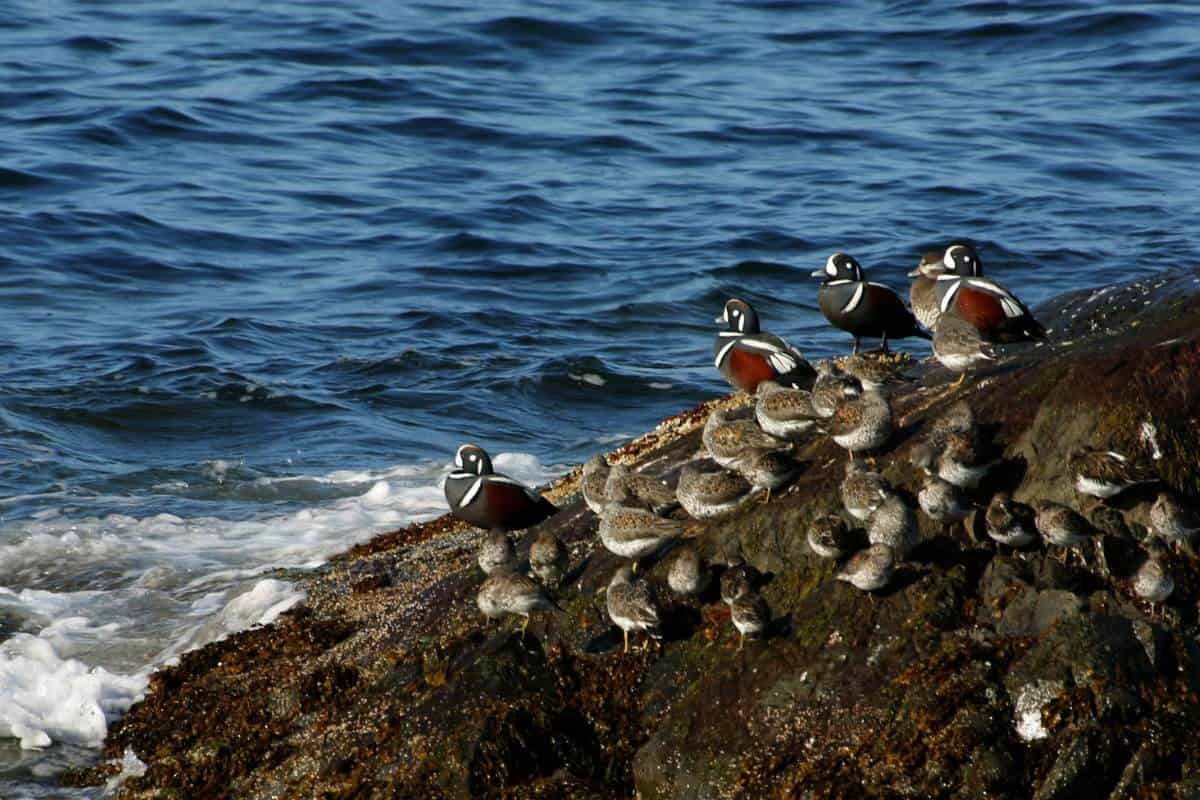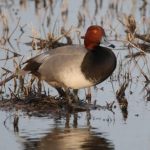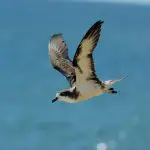Common Name: Harlequin Duck
Scientific Name: Histrionicus histrionicus| Size | Diet | Range in Hawaii | Status in Hawaii |
|---|---|---|---|
| 15 in. | crustaceans, mollusks, insects, and even small fish | Unknown | Least Concern |
The Harlequin duck, scientifically known as Histrionicus histrionicus, gets its name from the striking patterns adorning its feathers, resembling the garb of a playful jester from Italian Commedia dell’arte. Surprisingly, while the Harlequin duck is a common sight in its traditional habitats, it is an uncommon visitor to the Hawaiian Islands.
Due to their strong affinity for cold, fast-flowing waters, Harlequin ducks are typically found in mountainous regions or coastal areas with rocky shores, which are absent in the Hawaiian archipelago. Nonetheless, nature has a way of surprising us, and there have been a few reported sightings of this rare and captivating species in Hawaii, making for a tantalizing mystery for bird enthusiasts.
Harlequin Duck
Appearance
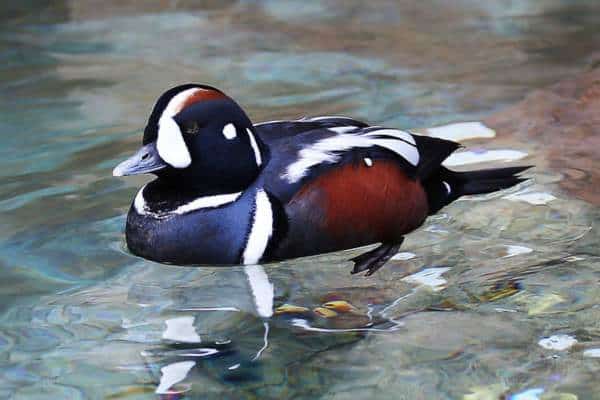
Meet the Harlequin duck, a small sea duck species that never fails to impress with its striking appearance. Standing at around 15 inches (38 centimeters) in length, this avian wonder is a delightful combination of elegance and vibrancy.
The male Harlequin duck steals the show with its mesmerizing plumage. Its head showcases an intricate pattern of deep blues and velvety purples, adorned with delicate white crescent-shaped markings around its eyes.
A splash of chestnut color highlights its sides, accentuating its slender silhouette. Meanwhile, its body is adorned with a kaleidoscope of blues, grays, and whites, resembling a painter’s brushstrokes on a living canvas.
In contrast, the female Harlequin duck boasts a more subtle yet refined appearance. Her feathers display a mottled blend of browns and grays, expertly camouflaging her amidst rocky coastal habitats. This natural camouflage helps protect her and her young offspring from potential predators.
Diet
The Harlequin duck’s diet primarily consists of small aquatic invertebrates. With their remarkable diving abilities, these birds can effortlessly plunge into the depths of rivers and coastal waters to secure their meals. Their menu includes a delectable assortment of crustaceans, mollusks, insects, and even small fish.
Nesting
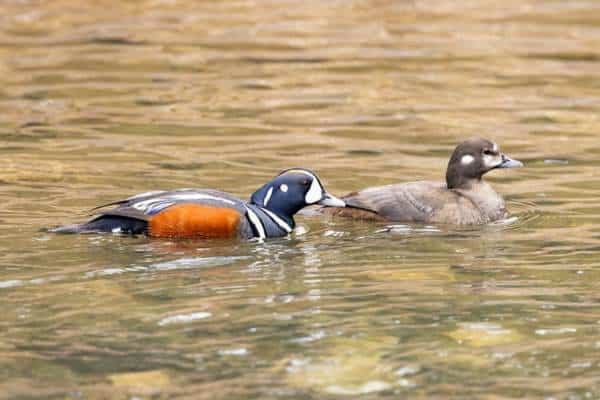
Unlike many other birds that build intricate nests in trees or on the ground, the Harlequin duck takes a more unconventional approach. They prefer to nest in secluded and hard-to-reach spots, often nestled among rocks or in crevices along rugged coastlines. These natural nooks and crannies provide protection from predators and the turbulent coastal elements.
The female Harlequin duck plays the leading role in constructing the nest. Using a combination of grasses, twigs, and moss, she meticulously arranges a cozy cup-shaped structure within the chosen sheltered location. The soft lining, often made of down feathers, ensures warmth and comfort for the eggs and hatchlings.
One remarkable aspect of Harlequin duck nesting behavior is their ability to choose nesting sites in close proximity to fast-flowing rivers. The female carefully selects locations near these rushing waters, allowing her to lead her ducklings to the river’s edge shortly after hatching. This strategic decision helps ensure the safety and survival of the young, as they swiftly make their way to the water, guided by their watchful mother.
Once the nest is complete and the eggs are laid, the female Harlequin duck diligently incubates them for around 28 to 30 days. During this period, the male stands guard, keeping a vigilant eye for any potential threats. Together, they demonstrate a strong sense of parental commitment and teamwork, ensuring the survival of their offspring.
As the eggs hatch, a tiny fleet of downy ducklings emerges into the world. With their mother’s guidance, they quickly make their way to the water, where they will learn to swim and navigate the currents under her watchful eye. The rugged nesting sites and the proximity to the water provide a perfect launching point for the ducklings’ exciting journey into the wild.
Behavior
One of the most remarkable behaviors of the Harlequin duck is its expert diving prowess. With their streamlined bodies and webbed feet, they effortlessly plunge beneath the water’s surface in search of food.
The duck’s ability to remain submerged for extended periods, often reaching depths of up to 60 feet (18 meters), demonstrates its remarkable adaptation to an aquatic lifestyle. These agile divers navigate the underwater world, employing their sharp bills to capture small fish, insects, and crustaceans, showcasing their specialized hunting techniques.
During the breeding season, the Harlequin duck’s behavior takes on an enchanting display of courtship rituals. The males engage in spirited and elaborate displays to attract the attention of the females.
They bob their heads, display their vibrant plumage, and emit a variety of melodious calls to proclaim their presence and woo potential mates. These courtship performances not only showcase the male’s physical prowess but also serve as a means of establishing social hierarchies and asserting their reproductive rights.
Social interactions among Harlequin ducks are also noteworthy. They often form small groups or pairs during the non-breeding season, engaging in communal feeding and roosting. These social bonds foster a sense of cooperation and safety, as the ducks rely on each other’s presence for protection against predators and the harsh elements.
Furthermore, the Harlequin duck exhibits strong site fidelity, returning to the same breeding and wintering grounds year after year. This behavior demonstrates their attachment to specific habitats and their ability to navigate vast distances during their migratory journeys.
Habitat

The Harlequin duck seeks solace in rugged and pristine habitats. From fast-flowing mountain rivers to rocky coastal shores, it finds sanctuary in unspoiled environments. These untouched landscapes provide the perfect nesting sites and abundant resources for this remarkable bird.
Range
The Harlequin Duck has been accidentally spotted in Hawaii. According to the British Columbia Conservation Data Centre, which tracks the distribution of the Harlequin Duck, there have been a few sightings of the species in Hawaii in recent years.
These sightings are considered to be rare and accidental, as the Harlequin Duck is not a native species to Hawaii and is not known to breed or establish a population in the islands. The Harlequin Duck’s natural range is primarily in northern regions of North America, where it breeds along fast-moving streams and rivers in forested areas.
Conservation Status
The Harlequin duck holds a relatively stable conservation status, classified as a species of “Least Concern” by the International Union for Conservation of Nature (IUCN). This designation suggests that the overall population of Harlequin ducks is currently stable and not facing immediate threats of extinction.
Interesting Facts
1. Feeding Finesse
Harlequin ducks have a unique feeding behavior called “wing-flashing.” They rapidly beat their wings while swimming on the water’s surface, creating disturbances that flush out small invertebrates, making them easier to catch.
2. Limited Vocalizations
Compared to other ducks, the Harlequin duck has a relatively limited range of vocalizations. Their vocal repertoire includes soft croaks and low whistles, used for communication during courtship displays and in group interactions.
3. Geological Time Survivors
Harlequin ducks are believed to have existed for millions of years, with their lineage dating back to the late Miocene epoch. Their ability to adapt and persist throughout geological time underscores their resilience as a species.
4. Cavity Nesters
In some cases, Harlequin ducks have been observed using cavities in trees as nesting sites, although this behavior is less common than their preference for rocky crevices along rivers or coastlines.
5. Year-Round Diving
Unlike many other duck species, Harlequin ducks are known to dive for their food year-round. They are adapted to withstand the colder waters of their habitats and can even dive beneath ice to find their prey.
Frequently Asked Questions
1. Why are Harlequin ducks called sea ducks?
Harlequin ducks are categorized as sea ducks due to their preference for coastal habitats and their strong association with marine environments. They are often found in areas with rocky shores, fast-flowing rivers, and estuaries, where they rely on both freshwater and saltwater resources for their survival.
2. How long do Harlequin ducks live?
Harlequin ducks have an average lifespan of around 10 to 15 years in the wild. However, individual longevity can vary based on various factors, including habitat quality, availability of food resources, and exposure to threats or disturbances.
3. Can Harlequin ducks interbreed with other duck species?
While interbreeding between different duck species can occur, it is relatively rare between Harlequin ducks and other species. Genetic isolation and differences in breeding behaviors and habitat preferences generally prevent interbreeding.
4. Can Harlequin ducks be seen in urban areas?
Harlequin ducks typically inhabit remote and pristine habitats, away from urban areas. However, there have been occasional sightings of Harlequin ducks in coastal or riverine urban environments, particularly during migration or in areas with suitable habitat conditions.
5. Can I keep a Harlequin duck as a pet?
Harlequin ducks are wild waterfowl and are not suitable as pets. It is important to respect their natural habitat and conservation needs by appreciating them in the wild or through responsible wildlife observation programs.
